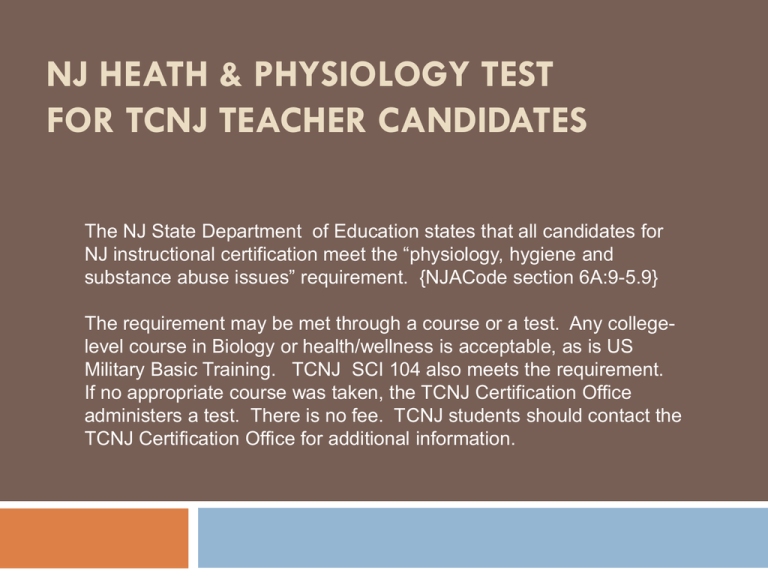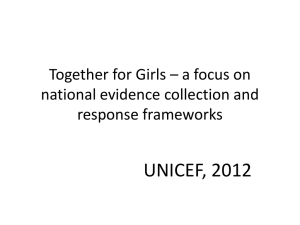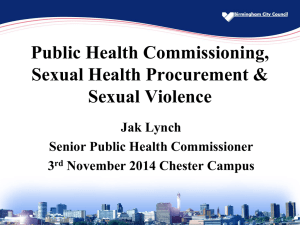
NJ HEATH & PHYSIOLOGY TEST
FOR TCNJ TEACHER CANDIDATES
The NJ State Department of Education states that all candidates for
NJ instructional certification meet the “physiology, hygiene and
substance abuse issues” requirement. {NJACode section 6A:9-5.9}
The requirement may be met through a course or a test. Any collegelevel course in Biology or health/wellness is acceptable, as is US
Military Basic Training. TCNJ SCI 104 also meets the requirement.
If no appropriate course was taken, the TCNJ Certification Office
administers a test. There is no fee. TCNJ students should contact the
TCNJ Certification Office for additional information.
SHAPING YOUR HEALTH
THE INFORMATION ON THE FOLLOWING SLIDES RELATE TO THE
TCNJ-ADMINISTERED TEST IN PHYSIOLOGY, HYGIENE, AND
SUBSTANCE ABUSE ISSUES, WHICH MEETS THE NJ STATE
DEPARTMENT OF EDUCATION REQUIREMENT IN THIS AREA.
CONTENT MATTER FOR ALL TEST QUESTIONS ORIGINATES FROM
THIS DOCUMENT.
Traditional Health Definitions
Concerns
Morbidity: pertaining to illness and disease
Mortality: pertaining to death
Health Care
Seek medical treatment when ill or injured
Preventative or prospective medicine
Identifying risk factors and high-risk health behaviors to
lower the risk of illness
Empowerment-individuals or groups gain increasing control
over their health
Wellness
A process intended to aid individuals in unlocking
their full potential through the development of an
overall wellness lifestyle.
Emphasis on lifestyle
May
not focus on mortality and morbidity but in
practice shares many risk-reduction activities with health
promotion approaches
Changing Unhealthy Behaviors
Several factors influence a person’s desire to change a health
behavior
The person must:
1.
Know the behavior is associated with a health problem
2.
Accept that the behavior increases personal risk for the health
problem
3.
Recognize that risk-reduction intervention programs exist and
can be effective
4.
Believe the benefits of the new behavior justify the change in
behavior
5.
Feel that significant others will be accepting of such changes
ACHIEVING
PSYCHOLOGICAL HEALTH
Emotional Intelligence
Ability to understand others and act wisely in
human relations
5 primary domains:
1.
2.
3.
4.
5.
Know your emotions
Manage your emotions
Motivate yourself
Recognize emotions in others
Handle relationships
Keys to Psychological Health
Develop communication skills to foster improved
social relationships
Verbal
communication-be a skilled sender and listener
Nonverbal communication-facial expression, eye
contact, personal space, body posture
Managing conflict
Listen
Focus
on what to say and how to say it
Use assertive communication with “I” statements
Keys to Psychological Health
Cultivate a sense of humor to build a positive
outlook on life
MANAGING STRESS
What Is Stress?
Stress
Stressor
Factors or events, real or imagined, that elicit a state of
stress
Eustress
Physiological and psychological state of disruption
Stress than enhances quality of life
Distress
Stress the diminishes quality of life
Stress Response
Physiological and psychological responses to
positive or negative events that are disruptive,
unexpected, or stimulating
Learned and conditioned habits adopted early in
life
Basic human survival mechanism
Effects of Stress
Stress and immunity
Chronic
stress may cause the immune system to be
under- or overactive
Stress and cardiovascular disease
Type
A personality: competitive, ambitious, impatient
Associated
Type
with heart attacks
B personality: relaxed, patient
PHYSICAL FITNESS
Four Components of Physical Fitness
Cardiorespiratory endurance
Aerobic
Muscular fitness
Strength
vs. anaerobic exercise
vs. endurance
Flexibility
Body composition
Cardiorespiratory Endurance
Ability of heart, lungs and blood vessels to process
and transport oxygen over a period of time
Produced by exercise involving continuous, repetitive
movements
Examples:
brisk walking, jogging, cycling
Aerobic (with oxygen) energy production
Structural and functional benefits
Muscular Fitness
Strength: Ability to contract skeletal muscles to a
maximal level
Endurance: Ability to contract skeletal muscles
repeatedly over a long period of time
Improved by performing repeated contractions at
less than maximal levels
Flexibility and Body Composition
Flexibility: Ability of your joints to move through an
intended range of motion
Body composition: The make-up of the body in terms
of muscle, fat, water, and minerals
Workout Routine
Warm-up (5-10 minutes of slow, gradual, comfortable
movements related to the upcoming activity; end with
a period of stretching)
Conditioning (cardiorespiratory endurance, strength
training, and/or flexibility workout following ACSM
guidelines)
Cooldown (5-10 minutes of relaxing exercises to
return the body to resting state)
How Hard Should I Train?
Intensity
Target
heart rate (THR) = 65-90% of maximal heart
rate
Maximum heart rate can be estimated by subtracting
your age from 220
Target heart rate range= (220-age) x 65-90%
NUTRITION AND DIET
Carbohydrates
Major energy source: 4 calories/gram
Types
Monosaccharides
Disaccharides
Polysaccharides
Recommended intake: 45-65% of total calories
from carbohydrates
Fats
Functions: Insulation, carrier of vitamins, storage of
long-term energy, and satiety
Energy source: 9 calories/gram
Types
Saturated
Monosaturated
Polysaturated
Trans
Recommended intake: 20-35% of total calories
Fiber
Cellulose-based plant material that cannot be digested
Provides no energy: 0 calories/gram
Types
Benefits
Soluble (gel-forming)
Insoluble (absorbs water)
Moves stool through digestive tract
Lowers blood cholesterol levels
Steadies blood sugar levels
Recommended: 21-38 grams/day
Most American adults: 11 grams/day
Vitamins
Organic compounds needed in small amounts for
normal growth, reproduction, and maintenance of
health
Serve as co-enzymes
Provide no energy: 0 calories/gram
Types
Water soluble
B-complex vitamins and vitamin C
Fat soluble
Vitamins A, D, E, K
Vitamins: Should I Take a Supplement?
Following dietary recommendations would allow most
Americans to meet their nutrient needs without
supplements
Many people eat too many nutrient-deficient foods
Caution with using supplements
Hypervitaminosis = toxicity
Megadoses of any vitamin can be harmful
Recommendations for certain groups
Folic acid, vitamin B-12, vitamin D
MAINTAINING A HEALTHY
WEIGHT
Defining Overweight and Obesity
Desirable Weight: weight range deemed
appropriate for people, taking into consideration
gender, age, and frame size
Overweight: a person’s excess fat accumulation
results in body weight that exceeds desirable
weight by 1-19%
Obesity: a person’s body weight is 20% or more
above desirable weight
Causes of Obesity
Caloric balance: energy intake vs. energy output
Intake = Output: caloric balance
Intake > Output: positive caloric balance
Output > Intake: negative caloric balance
Weight gain
Weight loss
Energy needs
Basal metabolic rate (BMR)
Activity requirements
Thermic effect of food
Causes of Obesity
Genetic factors
Physiological and hormonal factors
Hyperthyroidism
Hypercellular
obesity
Hypertrophic obesity
Metabolic factors
Set
point
Adaptive thermogenesis
Causes of Obesity
Family, social and cultural factors
Environmental factors
Local
environment
Packaging and price
Unit bias
Psychological factors
Weight Management Strategies: Lifestyle
Approaches
Balanced diet supported by portion control
Moderate physical activity
60 minutes/day for weight maintenance
90 minutes/day for weight loss and maintenance
Sleep
Lifestyle support and problem solving
Anorexia Nervosa
Diagnostic Criteria
Body weight 15% or more below desirable weight
Fear of weight gain distorted body image
In women, absence or 3 or more menstrual periods
In men, decreased sex hormone
Serious medical complications, including death
Treatment: medical and dietary interventions,
psychological treatment
Bulimia Nervosa
Diagnostic Criteria
Binge eating 2 or more times/week for at least 3 months
Lack of control over bingeing
Inappropriate compensatory behaviors (purging)
Vomiting or use of laxatives, diuretics, or other medications
Excessive exercise
Fasting
Over concern with body image
Serious medical complications
Treatment: nutritional and psychological counseling,
medical consultation
DRUG AND ALCOHOL USE
The Central Nervous System
Normal nerve activity
Neurotransmitters deliver message to receptors and returns
to cell
Drug interference
Alters deactivation, allowing continuous stimulation
Allows continuous slow release of neurotransmitter
Produces an altered neurotransmitter
Blocks the release of the stimuli completely
Drug Misuse and Abuse
Drug misuse: inappropriate use of legal drugs
intended to be medications
Intentional
or unintentional
Drug abuse: any use of a legal or illegal drug in a
way that is detrimental to health or well-being
Stimulants
Key actions: stimulates the function of the central
nervous system
Increase heart rate, blood pressure, brain function
Feelings of energy, exhilaration
Examples
Cocaine
Amphetamine
Methamphetamine
Caffeine
Ritalin
Ephedra
Depressents
Key actions: slow the function of the central nervous
system
Reduced heart and breathing rates, blood pressure
Lowered inhibitions, impaired judgment
Sedation, drowsiness, loss of consciousness
Examples
Barbiturates
Rohypnol
Alcohol
Tranquilizers
GHB
Narcotics
Key actions
Relief of pain, euphoria
Reduced heart rate and blood pressure
Sedation, drowsiness, confusion
Natural and synthetic; derived from the Oriental
poppy plant
Examples
Opium
Morphine
Heroin
Oxycodone
Inhalants
Volatile compounds
Key actions
Unpredictable, drunk-like effects; aggression
Euphoria
Damage to respiratory and cardiovascular systems
Examples
Gasoline
Glues
Paint
Aerosol propellants
Nitrites (“laughing gas”)
Alcohol Consumption
One drink:
12
ounces of beer
5 ounces of wine
1.5 ounces of liquor
Current use: Consumption of least one drink in the
past 30 days
Binge drinking: Consumption of five or more drinks
on the same occasion on at least 1 day in the last 2weeks
Alcohol-Related Social Problems
Accidents
Motor
vehicle collisions
Falls
Drowning
Fires
and burns
Crime and Violence
Suicide
Organizations That Support
Responsible Drinking
Mothers Against Drunk Driving (MADD)
Students Against Destructive Decisions (SADD)
BACCHUS
GAMMA Peer Education Network
Alcohol Advertising
Targets minorities, women, and youth
College
advertising
Wine cooler ads
Concentration of liquor stores and advertising in lowincome, ethnic communities
Treatment for Alcohol Problems
Rehabilitation centers
Hospitals
Medication
Counseling
Support groups
Alcoholics
Anonymous
Al-Anon and Alateen
Marketing of Tobacco Products
Controversy about advertising due to industry’s
knowledge of the health risks
Restrictions on marketing of all tobacco products,
BUT
Magazine
advertising has increased
Especially
Free
in magazines with 15% or more youth readership
distribution of cigarettes in bars and restaurants
Luring teens through anti-smoking ads
Development of Dependence
Dependence: Physical and/or psychological need to
continue the use of nicotine
Physical dependence
Tolerance
Withdrawal
Titration
Particular
level of a drug within the body
Adjusting the level of nicotine by adjusting the rate of
smoking
Prevention and Intervention
Preventing teen smoking
Targeted
audience
Governments policies
Restrictions
on advertising and promotions
Funding for smoking education
Early childhood intervention
Decision
making skills
Critical thinking and refusal skills
Support for smoke-free environments
Chronic Obstructive Lung Disease
Chronic bronchitis
Persistent
inflammation or infection of the smaller
airways within the lungs
Pulmonary emphysema
Irreversible
disease process in which the alveoli are
destroyed
Significant impact on quality of life
Smokeless Tobacco Use
Types
Chewing
tobacco
Snuff
Risks associated with use
Leukoplakia
Erythroplakia
Periodontal
Oral
disease
cancer
Nicotine addiction
Other health risks
CANCER
Cancer
Cell regulation problem causing abnormal
cell growth
Regulatory genes
Genes
that control cell specialization, replication, DNA
repair, tumor suppression
Oncogenes
Faulty
regulatory genes believed to activate the
development of cancer
Proto-oncogenes
Normal
regulatory genes that may become oncogenes
The Cancerous Cell
Characteristics:
Infinite
life expectancy due to telomerase
Lacks contact inhibition
Spreads to distant sites via metastasis
Commands the circulatory system to provide additional
blood supply (angiogenesis)
Benign tumors do not spread but can be dangerous if they crowd
out normal tissues
Skin Cancer
Risk factors
Prevention
Reduce exposure to sun’s rays, use sunscreens, avoid tanning
booths
Early detection
Severe sunburn during childhood, chronic sun exposure during
young adulthood
Self-examination (see next slide)
Treatment
Surgery, chemotherapy, interleukin-2
Preventive Measures
Know your family history
Select and monitor your occupation carefully
Do not use tobacco products
Monitor environmental exposure to carcinogens
Follow a sound diet
Control your body weight
Exercise regularly
Limit your exposure to the sun
Consume alcohol in moderation, if at all
Treatment of Cancer
Surgery
Radiation
Chemotherapy
New therapies
PREVENTING INFECTIOUS
DISEASES
Infectious Disease Transmission
Pathogen: A disease-causing agent
Epidemic: A highly significant increase in the
number of cases of an infectious illness existing in a
given time period in a given geographical area
Pandemic: An epidemic that has crossed national
boundaries, thus achieving regional or international
status
Example:
HIV/AIDS
Pathogens
Viruses
Prions
Bacteria
Fungi
Protozoa
Rickettsia
Parasitic worms
Chain of Infection
Chain of Infection
Agent: Causal pathogen
Reservoir: Pathogen’s environment
Portal of exit
Mode of transmission
Direct
Indirect
Port of entry
New host
HIV/AIDS
Human immunodeficiency virus (HIV)
Acquired immunodeficiency syndrome (AIDS)
HIV attacks the helper T cells of the immune system
Spread
Direct contact involving the exchange of body fluids (blood,
semen, vaginal secretions)
Sharing of hypodermic needles
Infected blood products
Perinatal transmission (mother to fetus or newborn)
HIV/AIDS
HIV cannot be transmitted by sweat, saliva, or tears,
even though trace amounts of HIV are observed
Women are at higher risk than men of contracting
HIV from an infected partner
HIV concentration is higher in semen compared with
vaginal secretions
Treatment of HIV Infection
No cure at this time
HAART (highly active antiretroviral therapy) can
significantly reduce viral load
Antiviral drugs, usually taken in combination
Nucleoside/nucleotide reverse transcriptase inhibitors
Non-nucleoside reverse transcriptase inhibitors
Protease inhibitors
Fusion inhibitors
CCR5 antagonists
Drug resistance
Prevention of HIV Infection
Learn the sexual history and HIV status of your partner
Limit the number of sexual partners
Use condoms correctly and consistently
Avoid contact with body fluids
Curtail the use of drugs
Never share hypodermic needles
Refrain from sex with known injectable drug users and
other high-risk partners
Get regular tests for STDs
Do not engage in unprotected anal intercourse
ORIGINS OF SEXUALITY,
SEXUAL BEHAVIOR AND
RELATIONSHIPS
Male Reproductive System
Testes
Sperm development
Interstitial cell-stimulating hormone
Follicle-stimulating hormone
Scrotum
Ducts
Seminal vesicles
Prostate gland
Cowper’s glands
Penis
Male Reproductive System
Female Reproductive System
Mons pubis
Labia majora and labia minora
Clitoris
Vestibule
Vagina
Uterus
Fallopian tubes
Ovaries
Female Reproductive System
Sexual Orientation
Heterosexuality – Sexual attraction to the opposite
gender
Homosexuality – Sexual attraction to the same
gender
“Gay” refers to a male homosexual
“Lesbian” refers to a female homosexual
Bisexuality – Sexual attraction toward both genders
Gender Identity Issues
Transsexualism – A person rejects his or her
biological sexuality
Transvestism – A person derives sexual pleasure
dressing in the opposite gender’s clothes
Transgenderism – Persons whose appearance and
behaviors do not conform to society’s traditional
gender role expectations
Relationships and Lifestyles
Marriage
Age at first marriage has increased
Gay and lesbian partnerships
Same-sex marriage
Relationships and Lifestyles
Divorce
Half of all marriages end in divorce
Unrealistic expectations
Singlehood
Cohabitation
Single parenthood
FERTILITY
Birth Control vs. Contraception
Birth control refers to all procedures and methods
that can prevent the birth of a child
Contraception refers to procedures used to prevent
fertilization
Behavioral Contraceptive Methods
Abstinence
No sexual activity
100% effective
Chance
No method used
15% use
effectiveness
Withdrawal (“coitus
interruptus”)
Removal of penis
from vagina before
ejaculation
73% use
effectiveness
Behavioral Contraceptive Methods
Periodic abstinence
(rhythm method)
• Calendar (calculating the
75% use effectiveness
unsafe days of a women’s
menstrual cycle)
• Basal body temperature
(rise in body temperature
correlates with timing of
ovulation)
• Billings cervical mucus
method (evaluate
consistency of vaginal
discharge to predict
ovulation)
• Symptothermal (combines
basal temperature and mucus
methods)
Over-the-Counter Contraceptive
Methods
Spermicides
Foams
Creams
Jellies
Films
Suppositories
Condoms
Male
Female
Contraceptive sponge
INFORMED HEALTH CARE
CONSUMER
Sources of Health Information
Family and friends
Advertisements and
commercials
Labels and directions
Folklore
Testimonials
Mass media
Health practitioners
Online computer
services
Health reference
publications
Reference libraries
Consumer advocacy
groups
Voluntary health
agencies
Government agencies
Qualified health
educators
Prescription vs. Over-the-Counter Drugs
(OTC)
Prescription drugs must be ordered for patients by
a licensed practitioner
Active ingredient is typically a higher concentration
than OTC
Price is much higher than OTC
Both are sold as brand name and generic
Both are regulated by the FDA
PROTECTING YOUR SAFETY
What Are Intentional Injuries?
Injuries purposefully inflicted
By
the victim
By another person
Interpersonal violence
Family violence
Violence in communities
Interpersonal Violence
Homicide
Assault
Robbery
Rates of violence crime
victimization
Stalking
Sexual harassment
Bias and hate crimes
Criminal
acts directed
at a person or group
solely because of a
specific characteristic
Race, religion, sexual
orientation, ethnic
background, etc.
Rape and sexual assault
Acquaintance/date rape
Family Violence
Use of physical force by one family member
against another with the intent to hurt, injure, or
cause harm
Intimate
partner violence
Maltreatment of children
Maltreatment of elders
Violence in Our Communities
School violence
Fights
Threats
Vandalism
Theft
Weapons-carrying
Violence in college
College
students experience less violence than sameage nonstudents
Youth and gang violence
Unintentional Injuries
Injuries that occur without anyone’s intending that harm
be done
Recognize that injuries are preventable
Be aware of injuries that occur in the following environments
or situations:
Motor vehicles
Home/residence
Recreational activities
Motor Vehicle Injuries and Safety
Motorcycle safety
Wear
a helmet
Protect skin from serious injury
Gloves,
Get
boots, heavy clothing
proper training
Don’t ride on wet roads if you don’t have to
Ride defensively
Avoid alcohol or other drug use
Residential Injuries and Safety
Poisonings
Falls
Exposure to heat, smoke, flames
Suffocation
Firearms
THE ENVIRONMENT AND
YOUR HEALTH
Personal Environment
Home
Neighborhood
Workplace
Health concerns of personal environment:
Indoor
air quality
Drinking water
Endocrine disrupters
Noise
Air Pollution
Sources
Internal combustion engines
Oil refineries, chemical production
Health effects
Carbon monoxide
Nitrogen and sulfur oxides
Impaired respiration
Lung tissue damage
Respiratory effects
Polycyclic aromatic hydrocarbons (PAHs)
Cancer
Fetal effects
Air Pollution
Tropospheric ozone (“smog”)
Lung damage
Reduced lung capacity
Respiratory distress
Air toxics
Cancer
Reduced fertility, birth defects
Taking Action
Check information on local air quality
Avoid outdoor activities during alerts
Limit personal contribution
Global Climate Change
Greenhouse gases
Trap heat radiated from the earth; increase global
temperature
Carbon dioxide, methane, nitrous oxide, tropospheric ozone,
water vapor
Effects of climate change
Coastal flooding
Increased frequency and severity of destructive weather
events
Expanded range of disease-carrying insects
Decreased air and water quality
Decreased food availability
Global Climate Change
Taking action
Conserve
electricity
Drive fuel-efficient vehicles
Use mass transit
Reduce, reuse, recycle
Purchase energy-efficient appliances
Vote, volunteer
DYING AND DEATH
Psychological Stages of Dying
Denial
Anger
Bargaining
Depression
Acceptance
Interacting with Dying People
Be genuine and honest
Provide emotional support
Allow people to express their feelings
End-of-Life Options and Decisions
Advance Healthcare
Directives
Living
will
Durable power of
attorney for health
care
Coping with the Death of a Loved One
Child
Miscarriage
Lost
after birth
Grieving
Parent
Spouse
Sibling
Rituals of Death
Cultural differences
Full funeral services
Embalming
Calling hours
Funeral service
Memorial service
Disposition of the body
Ground burial
Entombment
Cremation
Anatomical donation
Costs







